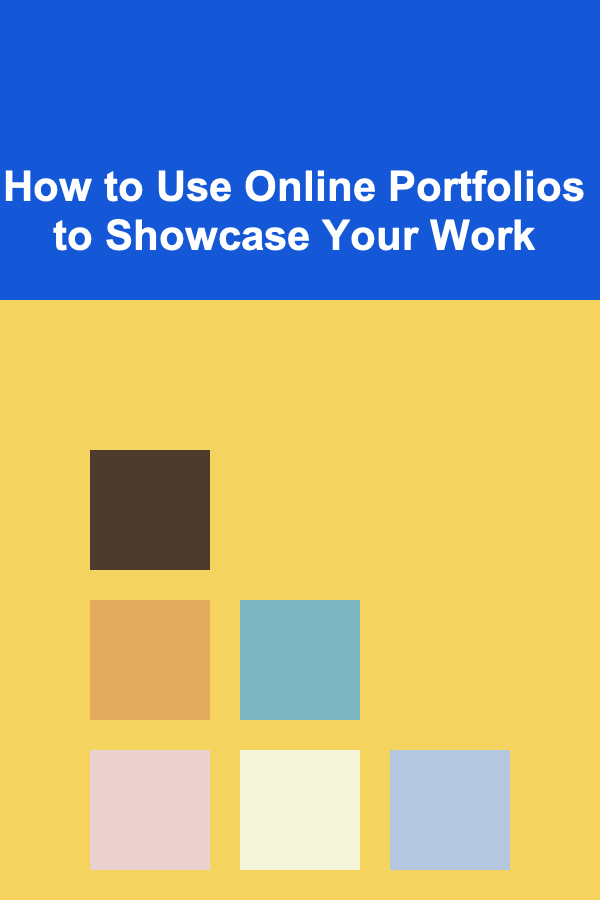
How to Use Online Portfolios to Showcase Your Work
ebook include PDF & Audio bundle (Micro Guide)
$12.99$6.99
Limited Time Offer! Order within the next:

In today's digital age, an online portfolio has become an essential tool for professionals across various fields. Whether you're a designer, writer, photographer, developer, or any other creative professional, having an online portfolio is not only a way to showcase your skills, but it also serves as a personal brand that can help you stand out from the competition.
In this actionable guide, we will walk you through how to effectively use an online portfolio to showcase your work, increase your visibility, and attract potential clients or employers. From creating a stunning portfolio to ensuring it drives the right kind of attention, this guide provides practical steps to help you make the most out of your online portfolio.
Choose the Right Platform
Before diving into building your portfolio, you need to select the right platform. There are many options available, depending on your field of expertise and the type of work you do. Here are a few things to consider when choosing a platform:
Personal Website (Custom Domain)
If you want full control over your portfolio, a personal website with a custom domain is the best option. It allows you to design the site to reflect your personal brand, ensuring that your work is presented exactly how you want it. Additionally, a custom domain (e.g., yourname.com) adds professionalism and makes it easier for potential clients and employers to find you.
To create a personal website, you can use website builders like:
- WordPress: Highly customizable, but may require some technical knowledge.
- Wix: User-friendly and provides a drag-and-drop interface.
- Squarespace: Known for beautiful templates and easy-to-use features.
- Webflow: Ideal for those with some web design skills who want more creative freedom.
Portfolio Platforms
For those who prefer something simpler and faster, portfolio platforms like Behance , Dribbble , or Carbonmade offer ready-made templates that you can customize to showcase your work. These platforms are great for designers, photographers, and other visual creatives, as they come with community support, allowing you to connect with like-minded individuals.
Advantages:
- Faster setup: Many of these platforms offer drag-and-drop functionality.
- Built-in audience: Behance, for instance, has a vast network of creatives who may stumble upon your work.
- Less technical maintenance: No need to worry about hosting or security.
Design a Visually Appealing Layout
The layout and design of your portfolio should reflect your personal style while remaining professional and user-friendly. Here are some design principles to consider:
Simplicity is Key
Your portfolio should be clean and easy to navigate. Too many colors, animations, or complicated features can distract visitors from your actual work. Stick to a minimalistic design that puts your projects front and center.
Responsive Design
Ensure that your portfolio is mobile-friendly. More and more people browse the web on their smartphones, and a non-responsive site can turn off potential clients or employers. Choose a platform or design theme that automatically adjusts to different screen sizes.
Showcase Your Work Prominently
The purpose of an online portfolio is to showcase your work, so make sure it's the focus of the design. Use high-quality images or videos to present your projects. If you're a photographer, for example, your portfolio should have large, clear images with little to no distractions around them.
User Experience (UX)
Easy navigation is crucial. Visitors should be able to find your work with minimal clicks. Organize your work by categories or industries (e.g., web design, photography, branding). Consider adding filters to help users navigate easily.
Showcase a Variety of Work
A good portfolio doesn't just showcase one type of project or skill. Potential clients or employers want to see the full range of what you can do. Here's how you can curate a diverse and effective portfolio:
Include Your Best Work
Quality over quantity. Select only your best and most recent projects that demonstrate your skills and creativity. It's better to have a few exceptional pieces than to include everything you've ever done. Keep your portfolio updated as you complete new projects.
Provide Context for Each Project
When you display your work, make sure to provide a brief description of each project. Explain the problem you were solving, your approach, and the results. This helps visitors understand the purpose behind the project and the value you brought to it. Even if your project seems self-explanatory, a short paragraph can give depth to your work and make it more compelling.
Show Your Process
Showing your creative process adds depth to your portfolio. This is especially important for designers, writers, and developers, as it demonstrates your problem-solving abilities. Consider including:
- Initial sketches or drafts
- Wireframes or prototypes (for designers and developers)
- Before-and-after images (for photographers or graphic designers)
By providing insight into your work process, you show potential clients how you think, collaborate, and solve problems.
Highlight Projects with Impact
If you've worked on projects that generated significant results or had a measurable impact (e.g., increased website traffic, improved sales, enhanced brand image), be sure to emphasize them. Case studies or testimonials from previous clients can add credibility to your portfolio and prove that your work has delivered results.
Include a Strong About Page
Your portfolio should include an About Page that introduces you to potential clients or employers. While your portfolio is about showcasing your work, the About Page is about showcasing who you are. Here's how to make it compelling:
Tell Your Story
Briefly explain who you are, your background, and your experience. Share why you're passionate about your field, what inspires you, and how you got started. A personal touch can help you connect with visitors.
Highlight Your Skills
List the skills you specialize in. Whether it's graphic design, content writing, web development, or something else, your skills should be clearly defined. If possible, back up your skills with certifications or awards to add more credibility.
Add a Professional Photo
Including a professional headshot helps humanize your online portfolio. It adds trustworthiness and makes you appear approachable to potential clients or employers.
Include Testimonials and Client Feedback
If you've worked with clients or been part of a team, include positive testimonials from them. Positive feedback from past clients or colleagues shows that you're reliable and competent. Testimonials are a form of social proof that enhances your portfolio's credibility.
Optimize for SEO
Your online portfolio should be visible to search engines so that potential clients can easily find you. This is where Search Engine Optimization (SEO) comes into play. Here are some steps to make your portfolio SEO-friendly:
Use Descriptive Titles and Alt Text
For every image, video, or project you upload, ensure that the titles and alt text are descriptive. For example, if you're showcasing a branding project, name the image "branding-identity-design-clientname" rather than using a generic file name like "image1.jpg." Alt text should describe the content of the image, which is also helpful for search engines.
Focus on Keywords
Research keywords that are relevant to your industry and audience. Use these keywords in your portfolio's content, meta descriptions, and project descriptions. For example, if you are a freelance graphic designer, include keywords like "freelance graphic designer" and "branding expert" in your copy.
Create a Blog (Optional)
A blog is a great way to boost your SEO and share your expertise. You can write about industry trends, your process, or case studies that showcase your work. Blogging will keep your portfolio fresh with content and increase your chances of ranking in search engine results.
Promote Your Portfolio
Creating a stunning portfolio is just one part of the equation; promoting it is the key to getting noticed. Here are some ways to drive traffic to your portfolio:
Share on Social Media
Share links to your portfolio on your professional social media profiles, such as LinkedIn, Twitter, and Instagram. Posting your projects on social media, along with a link to your portfolio, is an easy way to get your work in front of potential clients.
Network and Collaborate
Networking is essential in the creative industry. Attend industry events, both in-person and online, and share your portfolio with new connections. Collaboration with other professionals can also help you expand your reach.
Include Your Portfolio in Your Email Signature
Add a link to your portfolio in your email signature so that anyone you correspond with has easy access to it.
Conclusion
An online portfolio is an indispensable tool for professionals who want to showcase their work, build a personal brand, and attract clients or employers. By choosing the right platform, designing a user-friendly layout, showcasing a variety of work, and optimizing for SEO, you can create a portfolio that effectively presents your skills and experience. Once your portfolio is live, remember to promote it and keep it updated to ensure it continues to work for you in the long term.
By following these actionable steps, you'll be well on your way to building an online portfolio that not only highlights your best work but also opens the doors to exciting opportunities.
Reading More From Our Other Websites
- [Home Lighting 101] How to Install Under-Cabinet Lighting for a Modern Kitchen
- [Home Renovating 101] How to Incorporate Vintage Elements in Your Home Renovation
- [Metal Stamping Tip 101] The Complete Guide to Sheet Metal Stamping: Processes, Materials, and Best Practices
- [Home Family Activity 101] How to Organize a Family Talent Show with a Creative Twist
- [Home Budget Decorating 101] How to Create a Focal Point in Any Room Without Expensive Decor
- [Metal Stamping Tip 101] Best Design Considerations for Complex Geometries in Ultra‑Fine Metal Stamping
- [Personal Care Tips 101] How to Adapt Personal Care Routines for Different Climates
- [Home Storage Solution 101] How to Store Seasonal Items Efficiently in Your Home
- [Home Staging 101] How to Create a Focal Point in Every Room of Your Home
- [Gardening 101] The Ultimate Garden Crop Rotation Chart: Boost Yield & Soil Health in One Season

How to Clean and Maintain Your Home's Windows and Doors
Read More
How to Create an Effective Call-to-Action (CTA) Strategy: A Checklist for Conversions
Read More
How to Handle Tenant Subletting Requests
Read More
How to Make Money Online as an Engagement Strategist: 10 Actionable Ideas
Read More
How to Market and Sell Digital Music Players: An Actionable Guide
Read More
How to Plan a Cocktail Party with Unique Drink Recipes
Read MoreOther Products

How to Clean and Maintain Your Home's Windows and Doors
Read More
How to Create an Effective Call-to-Action (CTA) Strategy: A Checklist for Conversions
Read More
How to Handle Tenant Subletting Requests
Read More
How to Make Money Online as an Engagement Strategist: 10 Actionable Ideas
Read More
How to Market and Sell Digital Music Players: An Actionable Guide
Read More